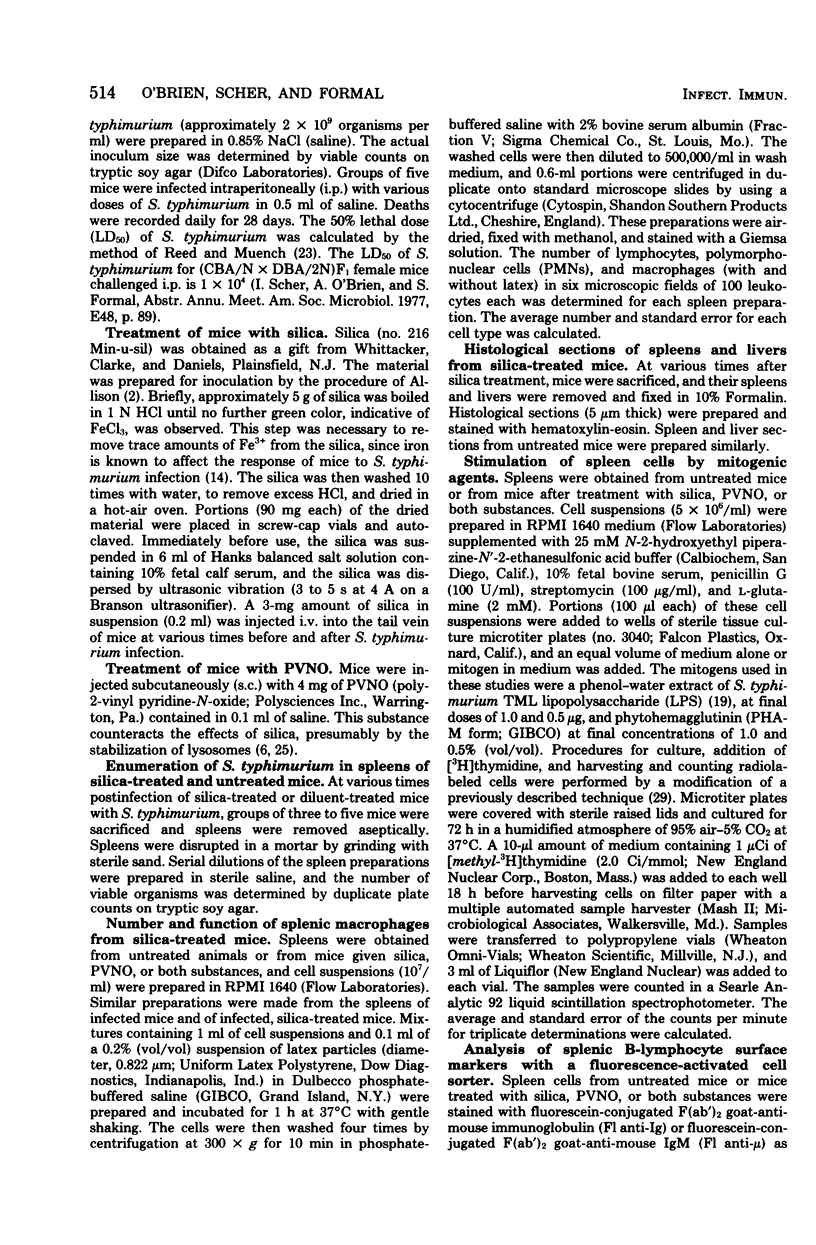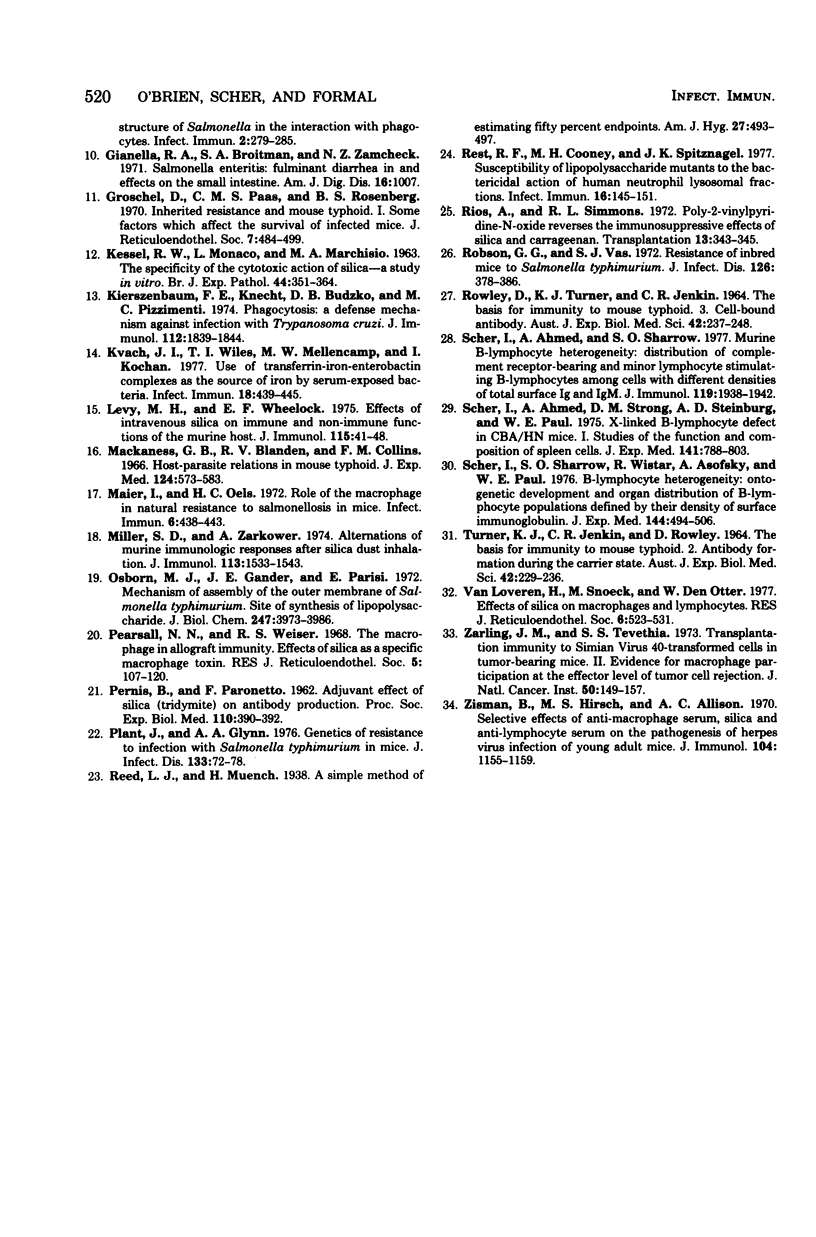Abstract
The role of macrophages in the innate immunity of (CBA/N female X DBA/2N male)F1 female mice to Salmonella typhimurium was assessed with silica, an agent which has been reported to selectively inactivate macrophages. Silica, administered intravenously to mice, markedly decreased the phagocytic capacity of splenic macrophages but had no effect on splenic responsiveness to the B-cell mitogen lipopolysaccharidide or the T-cell mitogen phytohemagglutinin, nor did it affect the frequency of surface immunoglobulin-positive cells (B cells). Silica given to mice 1 day before intraperitoneal challenge decreased the 50% lethal dose of S. typhimurium 100-fold. The incidence of survival of mice given silica up to 14 days before infection with a sublethal dose of organisms was also decreased. This susceptibility could also be demonstrated when silica was given 10 days, but not 20 days, after S. typhimurium infection. Poly-2-vinylpyridine-N-oxide, a lysosomal stabilizing agent, abrogated the silica effect. Deaths among silica-treated mice followed uncontrolled multiplication of the organism in the spleen. These results provide direct evidence that macrophages play an essential role in natural immunity to murine typhoid and demonstrate the efficacy of silica as a tool to analyze macrophage function.
Full text
PDF







Selected References
These references are in PubMed. This may not be the complete list of references from this article.
- Allison A. C., Hart P. D. Potentiation by silica of the growth of Mycobacterium tuberculosis in macrophage cultures. Br J Exp Pathol. 1968 Oct;49(5):465–476. [PMC free article] [PubMed] [Google Scholar]
- Allison A. C. Pathogenic effects of inhaled particles and antigens. Ann N Y Acad Sci. 1974;221:299–308. doi: 10.1111/j.1749-6632.1974.tb28229.x. [DOI] [PubMed] [Google Scholar]
- Blanden R. V., Mackaness G. B., Collins F. M. Mechanisms of acquired resistance in mouse typhoid. J Exp Med. 1966 Oct 1;124(4):585–600. doi: 10.1084/jem.124.4.585. [DOI] [PMC free article] [PubMed] [Google Scholar]
- Collins F. M. Vaccines and cell-mediated immunity. Bacteriol Rev. 1974 Dec;38(4):371–402. doi: 10.1128/br.38.4.371-402.1974. [DOI] [PMC free article] [PubMed] [Google Scholar]
- Cudkowicz G., Yung Y. P. Abrogation of resistance to foreign bone marrow grafts by carrageenans. I. Studies with the anti-macrophage agent seakem carrageenan. J Immunol. 1977 Aug;119(2):483–487. [PubMed] [Google Scholar]
- Davies R., Kotlarski I. The role of thymus-derived cells in immunity to salmonella infection. Aust J Exp Biol Med Sci. 1976 Jun;54(3):221–236. doi: 10.1038/icb.1976.23. [DOI] [PubMed] [Google Scholar]
- Giannella R. A., Broitman S. A., Zamcheck N. Salmonella enteritis. II. Fulminant diarrhea in and effects on the small intestine. Am J Dig Dis. 1971 Nov;16(11):1007–1013. doi: 10.1007/BF02235013. [DOI] [PubMed] [Google Scholar]
- Gröschel D., Paas C. M., Rosenberg B. S. Inherited resistance and mouse typhoid. I. Some factors which affect the survival of infected mice. J Reticuloendothel Soc. 1970 Apr;7(4):484–499. [PubMed] [Google Scholar]
- KESSEL R. W., MONACO L., MARCHISIO M. A. THE SPECIFICITY OF THE CYTOTOXIC ACTION OF SILICA--A STUDY IN VITRO. Br J Exp Pathol. 1963 Aug;44:351–364. [PMC free article] [PubMed] [Google Scholar]
- Kierszenbaum F., Knecht E., Budzko D. B., Pizzimenti M. C. Phagocytosis: a defense mechanism against infection with Trypanosoma cruzi. J Immunol. 1974 May;112(5):1839–1844. [PubMed] [Google Scholar]
- Kvach J. T., Wiles T. I., Mellencamp M. W., Kochan I. Use of transferrin-iron enterobactin complexes as the source of iron by serum-exposed bacteria. Infect Immun. 1977 Nov;18(2):439–445. doi: 10.1128/iai.18.2.439-445.1977. [DOI] [PMC free article] [PubMed] [Google Scholar]
- Mackaness G. B., Blanden R. V., Collins F. M. Host-parasite relations in mouse typhoid. J Exp Med. 1966 Oct 1;124(4):573–583. doi: 10.1084/jem.124.4.573. [DOI] [PMC free article] [PubMed] [Google Scholar]
- Maier T., Oels H. C. Role of the macrophage in natural resistance to salmonellosis in mice. Infect Immun. 1972 Oct;6(4):438–443. doi: 10.1128/iai.6.4.438-443.1972. [DOI] [PMC free article] [PubMed] [Google Scholar]
- Miller S. D., Zarkower A. Alterations of murine immunologic responses after silica dust inhalation. J Immunol. 1974 Nov;113(5):1533–1543. [PubMed] [Google Scholar]
- Osborn M. J., Gander J. E., Parisi E. Mechanism of assembly of the outer membrane of Salmonella typhimurium. Site of synthesis of lipopolysaccharide. J Biol Chem. 1972 Jun 25;247(12):3973–3986. [PubMed] [Google Scholar]
- PERNIS B., PARONETTO F. Adjuvant effect of silica (tridymite) on antibody production. Proc Soc Exp Biol Med. 1962 Jun;110:390–392. doi: 10.3181/00379727-110-27527. [DOI] [PubMed] [Google Scholar]
- Pearsall N. N., Weiser R. S. The macrophage in allograft immunity. I. Effects of silica as a specific macrophage toxin. J Reticuloendothel Soc. 1968 Apr;5(2):107–120. [PubMed] [Google Scholar]
- Plant J., Glynn A. A. Genetics of resistance to infection with Salmonella typhimurium in mice. J Infect Dis. 1976 Jan;133(1):72–78. doi: 10.1093/infdis/133.1.72. [DOI] [PubMed] [Google Scholar]
- ROWLEY D., TURNER K. J., JENKIN C. R. THE BASIS FOR IMMUNITY TO MOUSE TYPHOID. 3. CELL-BOUND ANTIBODY. Aust J Exp Biol Med Sci. 1964 Apr;42:237–248. doi: 10.1038/icb.1964.25. [DOI] [PubMed] [Google Scholar]
- Rest R. F., Cooney M. H., Spitznagel J. K. Susceptibility of lipopolysaccharide mutants to the bactericidal action of human neutrophil lysosomal fractions. Infect Immun. 1977 Apr;16(1):145–151. doi: 10.1128/iai.16.1.145-151.1977. [DOI] [PMC free article] [PubMed] [Google Scholar]
- Rios A., Simmons R. L. Poly-2-vinylpyridine N-oxide reverses the immunosuppressive effects of silica and carrageenan. Transplantation. 1972 Mar;13(3):343–345. doi: 10.1097/00007890-197203000-00026. [DOI] [PubMed] [Google Scholar]
- Robson H. G., Vas S. I. Resistance of inbred mice to Salmonella typhimurium. J Infect Dis. 1972 Oct;126(4):378–386. doi: 10.1093/infdis/126.4.378. [DOI] [PubMed] [Google Scholar]
- Scher I., Ahmed A., Sharrow S. O. Murine B lymphocyte heterogeneity: distribution of complement receptor-bearing and minor lymphocyte-stimulating B lymphocytes among cells with different densities of total surface Ig and IgM. J Immunol. 1977 Dec;119(6):1938–1942. [PubMed] [Google Scholar]
- Scher I., Ahmed A., Strong D. M., Steinberg A. D., Paul W. E. X-linked B-lymphocyte immune defect in CBA/HN mice. I. Studies of the function and composition of spleen cells. J Exp Med. 1975 Apr 1;141(4):788–803. [PMC free article] [PubMed] [Google Scholar]
- Scher I., Sharrow S. O., Wistar R., Jr, Asofsky R., Paul W. E. B-lymphocyte heterogeneity: ontogenetic development and organ distribution of B-lymphocyte populations defined by their density of surface immunoglobulin. J Exp Med. 1976 Aug 1;144(2):494–506. doi: 10.1084/jem.144.2.494. [DOI] [PMC free article] [PubMed] [Google Scholar]
- TURNER K. J., JENKIN C. R., ROWLEY D. THE BASIS FOR IMMUNITY TO MOUSE TYPHOID. 2. ANTIBODY FORMATION DURING THE CARRIER STATE. Aust J Exp Biol Med Sci. 1964 Apr;42:229–236. doi: 10.1038/icb.1964.24. [DOI] [PubMed] [Google Scholar]
- Van Loveren H., Snoek M., Den Otter W. Effects of silica on macrophages and lymphocytes. J Reticuloendothel Soc. 1977 Dec;22(6):523–531. [PubMed] [Google Scholar]
- Zarling J. M., Tevethia S. S. Transplantation immunity to simian virus 40-transformed cells in tumor-bearing mice. II. Evidence for macrophage participation at the effector level of tumor cell rejection. J Natl Cancer Inst. 1973 Jan;50(1):149–157. doi: 10.1093/jnci/50.1.149. [DOI] [PubMed] [Google Scholar]
- Zisman B., Hirsch M. S., Allison A. C. Selective effects of anti-macrophage serum, silica and anti-lymphocyte serum on pathogenesis of herpes virus infection of young adult mice. J Immunol. 1970 May;104(5):1155–1159. [PubMed] [Google Scholar]
- duBuy H. Effect of silica on virus infections in mice and mouse tissue culture. Infect Immun. 1975 May;11(5):996–1002. doi: 10.1128/iai.11.5.996-1002.1975. [DOI] [PMC free article] [PubMed] [Google Scholar]


